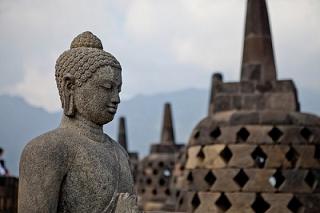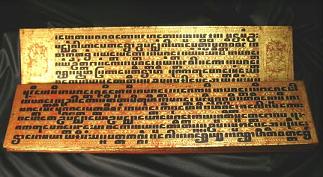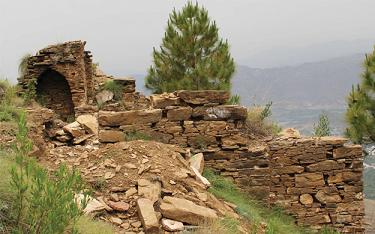Borobudur: A Reminder of Indonesia’s Buddhist Past
- Borobudur: A Reminder of Indonesia’s Buddhist Past
- Sri Lanka must ask India not to remove Pali Language from its Indian Administrative Service Examination
- A lost Nirvana: Swat’s window into the past closes as Kanderai slowly disappears
- Buddhist nun professors or none?
By Jonathan DeHart, The Diplomat, June 6, 2013
Jogjakarta, Indonesia -- In the misty jungles of Central Java's Kedu Valley, builders in the 8th and 9th centuries hauled 2 million stones from rivers and streams to erect Borobudur, a dazzling, 95-foot-tall, 55,000-square-meter step pyramid and Buddhist temple complex. Today, it serves as a reminder that a Buddhist kingdom, the Syailendra Dynasty, thrived for around five centuries (until the 10th century) in the heart of what is now Indonesia.
This would seem unlikely today, given the nation's status as the world's largest Muslim nation, but the Borobudur Temple compound (a UNESCO World Heritage Site) is in fact the world's largest Buddhist monument. The temple's historical significance is matched by its architectural grandeur, which is made all the more dramatic by views of steaming Mount Merapi, an active volcano that erupted as recently as 2010."Borobudur stands with Angkor in Cambodia, Lalibela in Ethiopia and Istanbul's Hagia Sophia, among the finest treasures of the world's religions," wrote Buddhist scholar Stephen Bachelor. "It's considered an essential stop for anyone who visits Java, whether jaunting from nearby Yogyakarta or moving slowly through the island heading for Bali and paradise islands beyond. It remains – far more so than many holy places around the region and the world – a place of pilgrimage and prayer." Built in three tiers, the temple's layout has a pyramidal base with five concentric terraces, above which a layer of three circular platforms lined with 72 stupas – each containing a statue of the Buddha – lead up to a massive stupa at the top. An aerial view of the magnificent structure can be seen here and photos of it are here.  Borobudur's vertical organization reflects Buddhist cosmology, according to which the universe is divided into three superimposing spheres: kamadhatu (desire), rupadhatu (forms) and arupadhatu (formlessness). Kamadhatu is embodied in the pyramidal base, while the five square terraces at the temple's mid level represent rupadhatu and the upper five circular platforms and crowing stupa correspond to the formless void from which all forms and desires emanate. Circumambulating the temple's terraces while chanting and meditating is a devotional practice. Borobudur's vertical organization reflects Buddhist cosmology, according to which the universe is divided into three superimposing spheres: kamadhatu (desire), rupadhatu (forms) and arupadhatu (formlessness). Kamadhatu is embodied in the pyramidal base, while the five square terraces at the temple's mid level represent rupadhatu and the upper five circular platforms and crowing stupa correspond to the formless void from which all forms and desires emanate. Circumambulating the temple's terraces while chanting and meditating is a devotional practice.Its similarity to a terraced mountain, notes UNESCO, the design of the structure harkens back to the island's ancient tradition of ancestor worship, and is combined with the Buddhist ideal of attaining – ascending to – Nirvana. For ancient sites, however, earning a spot on the well-trodden tourist path is a double-edged sword, added Bachelor: "With the growth of mass travel these and other temples and churches have become more than places of pilgrimage for the faithful. Tourists come to these places as well as believers – often in great numbers." The challenges were highlighted during the Waisak celebrations (for the Buddha's birthday) held at Borobudur last month, during which spectators reportedly showed a lack of respect for religious celebrants. For Bachelor, the pros of visiting still outweigh the cons: "But for those who can visit, sites like Borobudur… become real places with a place in modern society, and visitors hopefully gain a connection to and curiosity for the past, and an understanding of the value of preserving special places for future generations." Read More @ Source |
by Shenali D Waduge, Lankaweb, June 6, 2013
Colombo, Sri Lanka -- India's projection internationally as a country interested in preserving the Buddhist heritage and Indian Government promotions to encourage tourists to visit Buddhist sites in India as a custodian of Buddhist, has come in for a rude shock with the news that the Government of India has recently removed Pali – an ancient classical language being the language of propagation of Buddhist – as a subject from the main examination of the Civil Services (popularly known as Indian Administrative Services i.e. IAS) of India, 2013, which were under the purview of the UPSC (Union Public Service Commission). This news is most disturbing to the Buddhists the world over.
 The inclusion of Pali in this competitive examination was one of the major reasons that attracted many young prospective candidates for the Indian Administrative Service to opt to engage in Pali and Buddhist Studies. The examination was treated as a major lifeline in the preservation of the Pali language, and it was credited to have played an important role in stemming the decline of the study of Buddhist in its Indian homeland. The inclusion of Pali in this competitive examination was one of the major reasons that attracted many young prospective candidates for the Indian Administrative Service to opt to engage in Pali and Buddhist Studies. The examination was treated as a major lifeline in the preservation of the Pali language, and it was credited to have played an important role in stemming the decline of the study of Buddhist in its Indian homeland.Pali is the language that has to a great extent encapsulated the Buddha's teachings as contained in the Tipitaka, which is considered a treasure trove of Buddhist knowledge and an important carrier of the Buddhist doctrine throughout the world. The Pali language should not be allowed to become a victim of Indian bureaucracy and other hostile groups funded mostly from outside India who have a hidden agenda to weaken the status and influence of India's indigenous religions. As a leading Buddhist nation, Sri Lanka's President on behalf of the Buddhists in Sri Lanka and the world over must appeal to India not to turn its back on its Buddhist heritage and abandon in particular Pali – the language that Buddhist was spread globally. In view of Pali being an ecclesiastical language of Buddhist and very close to Magadhi (language of the Buddha) the Buddhists of Sri Lanka will give their whole hearted backing to the President in any such endeavour. Related story: Save Pali, ancient classical Indian language of Buddhist in India Read More @ Source |
|
Posted: 08 Jun 2013 05:00 PM PDT
by Fazal Khaliq / Fazal Khaliq, The Tribune, June 3, 2013
Kanderai, Pakistan -- Neglected by the government, Kanderai, the remains of one of the largest and most fascinating Buddhist settlements, will soon crumble to dust.
 << Illegal excavation and government apathy lay waste to historical site. PHOTOS: FAZAL KHALIQ /EXPRESS << Illegal excavation and government apathy lay waste to historical site. PHOTOS: FAZAL KHALIQ /EXPRESSThe settlement, locally known as Kanjar Kotey, has been mercilessly excavated and destroyed by smugglers. The site is located on top of a hill some three kilometres from Barikot Bazaar, close to Karakar Pass. Given its position and architecture, it is likely to have been a key Buddhist settlement. In its original form, Kanderai possibly included a principal courtyard, an assembly hall, a great vihara (quadrangle court outlined with small cells), a smaller vihara, and single storey cells. There also may have been multi-storey houses with stupas, cisterns, water tanks and isolated tower houses dotting the site. The remnants of cisterns and hydraulics coupled with the area's proximity to natural water sources point to potential large-scale farming activities. Amjad Ali, a local journalist passionate about archaeology, was spending part of his day exploring various aspects of the ruins. "I am really sorry to say illegal excavation has not been stopped," he told The Express Tribune, greatly disturbed by the sad state of Kanderai. Extensive excavation can be seen almost everywhere, as smugglers and fortune seekers seem to have ruthlessly destroyed whatever is left of the structures. "Many people, in groups or otherwise, come here with digging tools and metal detectors to search for coins. Then, they leave the site in a state of careless disrepair," pointed out a local farmer. "We have never seen marauders being stopped or even warned." Faisal Yousufzai, a student visiting the Buddhist archaeological spot, found the area beautiful to visit but shared concerns regarding the illegal activities which were continuing to go unchecked. "The government should protect it (Kanderai) by hiring guards to prevent further destruction," he argued. According to archaeological experts, Kanderai has the potential to reveal Swat's ancient association with Buddhism, religious tourism and great eras such as the reign of Emperor Asoka. But none of this can take place without legal protection. "Kanderai is probably the largest Buddhist settlement in the Swat Valley circa third and fourth century. It is a very large and important ruin, which covers more than three hectares and looks very much like the Takht Bhai ruins," explained Dr Luca Maria Olivieri, the Director of the Italian Archaeological Mission in Swat. The site should be notified and legally protected by the government, maintained Dr Olivieri. "If scientific excavation is carried out, rich discoveries are likely to be made …after excavation it will probably be one of the most exciting sites in Swat. People will have the same experience they get in Takht Bhai," he added. A rare clue into the region's phenomenal history, Kanderai might soon vanish if the loot and plunder combined with the lack of preservation continue. Without official protection as a heritage site, there will be nothing left to build archaeological tourism around. Insight into the lives of Buddhist monks and their wealthy patrons, who built these great sites as an act of worship, are still within reach at Kanderai. However, only scientific exploration of the most delicate nature can now be withstood by these already damaged ruins. Read More @ Source |
|
Posted: 08 Jun 2013 04:00 PM PDT
By Michaela Haas, The Washington Post, June 7, 2013
Dhramsala, India -- Buddhist women are celebrating a landmark victory: For the first time in the history of Tibetan Buddhist, 27 nuns have gathered in North India at Jamyang Choling Nunnery near Dharamsala and have begun their exams for the Tibetan equivalent of a Ph.D., the so-called Geshe-title.
 << The Buddha preaching to Khema, Queen of King Bimbisara << The Buddha preaching to Khema, Queen of King BimbisaraTo understand the impact and range of this decision, take a moment to imagine what it would be like if until now only men had been allowed to pass their doctorate exams. As many American students are preparing for their final exams and graduation celebration during these weeks, picture what this would look like if girls were excluded. This was the situation for women in the Himalayas—and it is about to change! So, why is this such a big deal and why did it take so long? After all, in the Western world the first professor degree was awarded to a woman at a European university almost 300 years ago, in 1732. (Scientist Laura Bassi taught physics at the University of Bologna.) And more than 2,500 years ago the Buddha himself allowed women into his order and ordained his own foster mother, Mahaprajapati. For complex historical and patriarchal reasons, the ordination lineage did not migrate when Buddhist spread from India to Tibet, thus outclassing the Tibetan Buddhist nuns as inferior. Tibetan Buddhist nuns have to travel to countries where the Chinese ordination lineage is alive to receive full ordination in a Buddhist lineage that they are not entirely familiar with. "Most Tibetan nuns don't have the means to travel to Hong Kong or Korea," says Jetsun Tenzin Palmo, the most senior Western born Tibetan Buddhist nun alive today, in the new book Dakini Power, "and even if they did, they want to be ordained in their own tradition, by their own lamas, in their own robes." A side-effect of this issue is that the nuns don't have equal access to the full curriculum – only fully ordained monastics can study ethics in their entirety. The spiritual leader of the Tibetans, His Holiness the Dalai Lama, has long been an advocate for the empowerment of women and recently reaffirmed enthusiastically that his successor could be a woman. He also insisted that there should be a doctorate degree for Tibetan Buddhist nuns. "I`m a feminist", he said at the Vancouver Peace Summit, "Isn`t that what you call someone who fights for women`s rights?" In April 2011, he advised the renowned Institute for Buddhist Dialectical Studies (IBD) in Dharamsala, India, to confer the degree of "Geshe" to Venerable Kelsang Wangmo, a German nun (formerly Kerstin Brunnenbaum). This was a historic milestone: Traditionally, Geshe degrees are conferred on monks after 12 or more years of rigorous study in Buddhist philosophy. For the first time in history, a nun received this degree, and even more surprising, a Western woman. In spring 2012, the Department of Religion and Culture of the Central Tibetan Administration convened a special meeting of abbots and scholars who decided unanimously that more nuns be allowed to be acknowledged for their academic achievements - a promise that is now becoming reality. The 27 nuns who are currently taking the exams will finally be rewarded for mastering more than 20 years of studying advanced Buddhist philosophy and they will be the first generation of female professors in the Tibetan tradition. The Dalai Lama has also publicly supported full ordination for nuns and equal access to education. "I think it's very important for women to try to appropriate all their rights. Among the Tibetan refugee community in India, I have for many years been advocating for the female side, the nuns' side," the Dalai Lama said. The Dalai Lama stresses that he cannot simply dictate change - the whole community of senior Tibetan masters needs to agree to change the traditional rules. Therefore a full-fledged discussion is in place about the position of Tibetan Buddhist nuns. To this day the female nuns have to observe 98 more precepts than the monks, including the rules that they have to obey the monks, can't give them advice, and even the most senior nun still has to take a lower seat than the greenest rookie monk. Tenzin Palmo seriously doubts that these extra precepts were really taught by the Buddha and has researched reasons to believe that they were added by later patriarchs to reflect the dominant views about females at that time. Tenzin Palmo was born as Diane Perry in London and shares her own insight into the hardships of following the Buddhist path as a Western woman. What started out as the most revolutionary welcome to women at the Buddha's time, has turned into a misogynistic adventure. "It's just time they get their act together!" Tenzin Palmo said pointedly when I visited her in the Himalayas, "and give the nuns their full ordination!" ---------------- Michaela Haas, PhD, is an international reporter, lecturer, and consultant. She is the author of "Dakini Power: Twelve Extraordinary Women Changing the Transmission of Tibetan Buddhist in the West," which was published by Snow Lion/Shambhala this April. Read More @ Source |